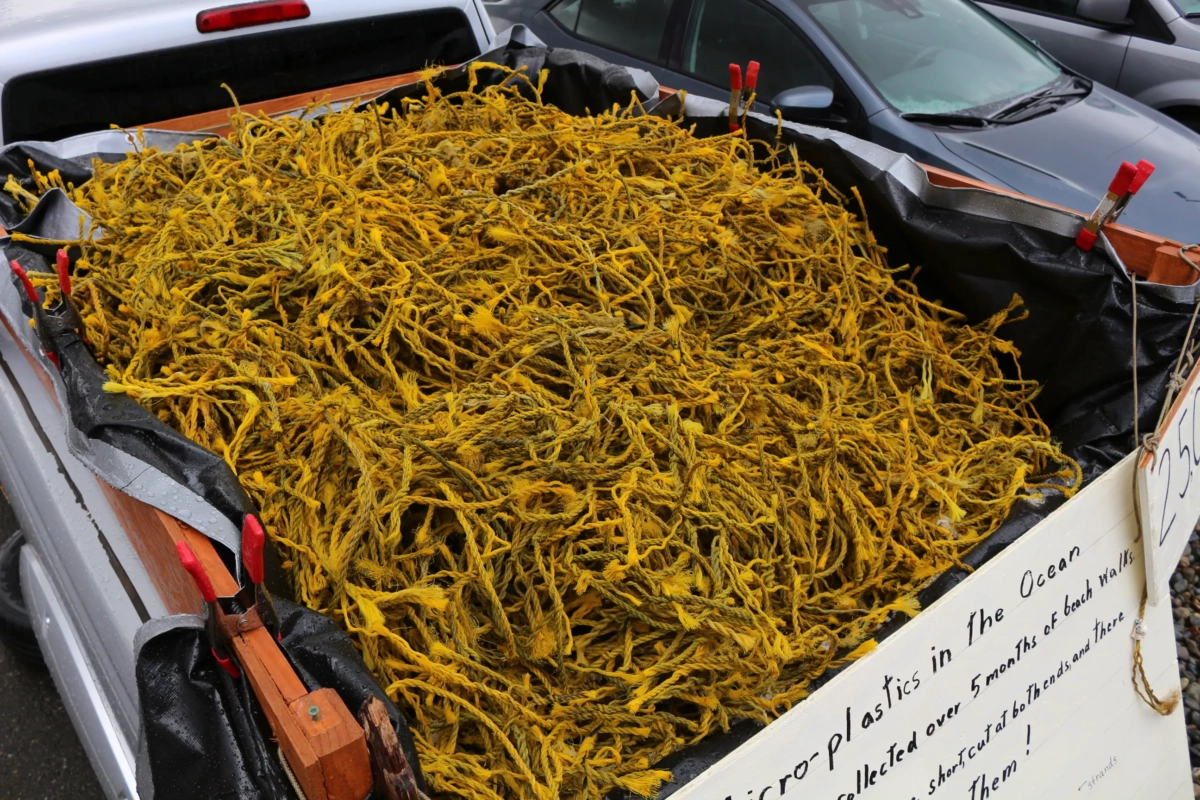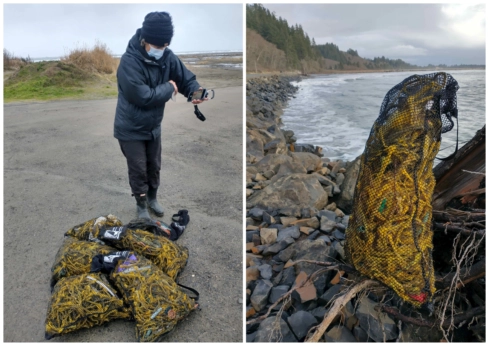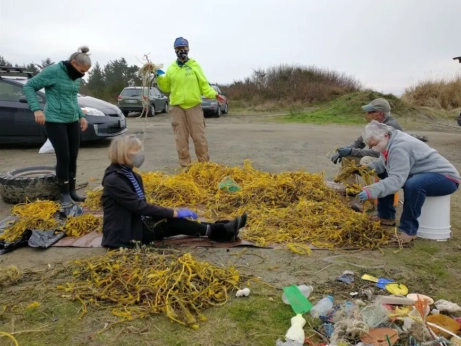When pieces of yellow rope kept washing ashore, industry and community got together to turn the tide.

When John Shaw took over as executive director of the Westport Maritime Museum in 2014, beach clean-ups practically came with the job. Walking along the beaches in southwest Washington state, volunteers would find the usual suspects—bits of plastic, water bottles, styrofoam—but there was something else that kept popping up over and over again in the sandy tide.
“I was always seeing these little segments of yellow rope,” says Shaw. “We would see thousands of them across the season.”
After asking around, Shaw realized that these little yellow ropes came from longline oyster aquaculture, an off-bottom growing technique that is particularly useful in areas where the bottom can’t support bottom-grown oysters due to the prevalence of burrowing shrimp. After the oysters are harvested, pieces of these ropes can end up back in the water, contributing to the issues of marine debris and microplastics pollution.
In 2019, Shaw called a meeting with the Pacific Coast Shellfish Growers Association and the Willapa-Grays Harbor Oyster Growers Association. He presented the issue, and a discussion ensued about how to solve the problem. Oyster growers such as Pacific Seafood began introducing processes to address these rope fragments. The industry response had an immediate effect.
In September of this year, Shaw went for a walk down a 2.5-mile stretch of beach that he visits frequently.
“Prior to [2018 or 2019], I would pick up 500 to 600 pieces of yellow rope in a walk and bring in multiple bags,” says Shaw. On this walk, he found only three or four individual pieces.
“We just saw this immediate decline in the material that was coming out of Willapa Harbor,” says Shaw. “It was stunning.”

Beach clean-ups helped pull tens of thousands of pieces of yellow rope out of the environment. (Photography courtesy of John Shaw)
The Cluster Buster
Beach clean-ups in Washington state resulted in the collection of tens of thousands of pieces of yellow rope. Yellow rope affects beaches in the Pacific Northwest and is one part of a larger issue of marine debris pollution. But unlike things such as water bottles and glass fragments, this yellow rope comes from one specific source.
Longline aquaculture uses yellow polypropylene rope. To grow oysters this way, you have to splice an oyster shell with seed on it into the rope. As the seeds grow, they form a cluster.
“You get this big, almost flower of oysters,” says Kyle Deerkop, Washington Shellfish Farm manager for Pacific Seafood. “One shell can turn into 10 to 15 oysters.”
When harvesting, you cut between the clusters. After the oysters have been harvested, you’re left with softball- or cantaloupe-sized balls of shells. The industry recycles these shells—either new oysters will be set on them in the hatchery or the shells will be spread on oyster beds to catch natural set oysters. The problem has been that these clusters dispersed for natural catch production still held onto their yellow rope segments. That rope would eventually end up floating in the water and washed up on the beach.
After the 2019 meeting, nonprofits such as the Surfrider Foundation and Twin Harbors Waterkeeper also got involved in trying to address the issue.
“There’s two things when you have a challenge like that. The first is to stop the flow of it to the environment,” says Deerkop. “And then the second is to clean up what’s out there.”

Yellow rope collected during beach clean-ups in southwest Washington. (Photography courtesy of John Shaw)
The industry and nonprofit groups worked to approach the issue from multiple angles—beach clean-ups, education and figuring out what interventions could intercept the yellow rope before it makes it back into the water. Pacific Seafood, with help from college interns from surrounding universities, got to work developing what they would end up calling the “Cluster Buster”—a machine that could take these shell clusters and break them apart, so that the rope within could be removed and disposed of. The Cluster Buster breaks apart the clusters but without damaging the shells. This is important, since the shells are usable for future growing operations. It took some trial and error to get it right.
“You don’t realize how much force it actually takes,” says Deerkop. “So, we were bending shafts, we were having to reconfigure the rollers.”

Left: The Pacific Seafood team picking rope from the “busted” clusters. Right: The team loads shells into the hopper. (Photography by Kyle Deerkop)
After they built their onsite Cluster Buster, they received funding from the Washington State Conservation Commission to develop a mobile version that could be used at the shell piles—not just those belonging to Pacific Seafood but also those of other companies. Longline oyster growers in Oregon and Washington will be able to borrow the mobile Cluster Buster, once processes are established for maintenance and repairs. A chance to use it annually would be sufficient for most growers, says Deerkop. Continued effort will be necessary to keep yellow rope numbers down.
Shaw is satisfied with the industry reaction. “I think that the industry should get kudos for having responded.”
Shared resource
In addition to the Cluster Buster, community engagement has resulted in other alternative endings for yellow rope. In one project, yellow rope collected during beach clean-ups was processed and delivered to Western Washington University, where it was used to make crab gauges, an industry tool to determine if a crab is big enough for harvest. In that instance, the yellow rope was recycled right back into the industry.
For Deerkop’s part, he and his farm team continue to go to beach clean-ups. He says it’s important to have the mindset of being invested in the health of the estuary, as a seafood company. Without clean water, he says, you can’t have clean shellfish.
“It is a shared resource, right? It’s important for our company and it’s important for the community.”
Neat!